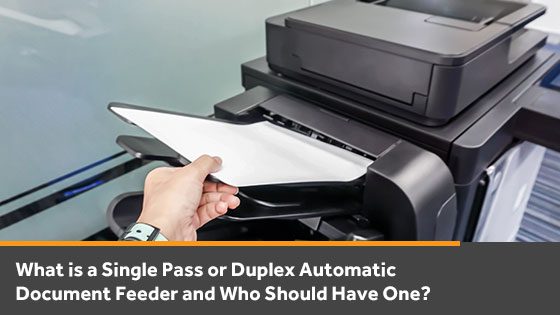If your company conducts business that involves high volumes of physical document handling, an automatic document feeder (ADF) might be for you. An automatic document feeder refers to a capability in scanners, fax machines, or printers that allows the device to process a stack of paper automatically.
Rather than having to put each page into the machine manually, automatic document feeders allow a user to program the machine, insert a large number of paper documents, and walk away. The ADF will take care of the rest.
Many companies that manufacture all-in-one devices, copiers, scanners, and fax machines add an automatic document feeder into the design of their devices or sell an extension that allows users to add an ADF later.
Different Types of Automatic Document Feeders
There are several different types of Automatic Document Feeders. Some ADFs can scan documents with a single pass, while others have to pass a document through multiple times. Among ADFs that are capable of scanning both sides of a page, there are two popular styles – those that can scan both sides at once and those that must feed a document through, scan one side, then flip the document over and scan the other side.
Single-pass document feeders can handle large scanning jobs much faster than other types of ADFs.
Reversing Automatic Document Feeders
Two different types of automatic document feeders can scan both sides of a page. First, you have Reversing Automatic Document Feeders (RADF). RADF’s scan a single side of a page first before flipping it over to scan the other side.
Single-Pass Document Feeders or Duplex Document Feeders
There is also what’s called a Duplexing Automatic Document Feeder (DADF). A DADF is a single-pass document feeder as it can scan both sides of a page simultaneously, meaning the page must only pass through the feeder once. Two advantages of Duplexing Automatic Document Feeders are that they are much faster and can cope with thick or damaged documents while minimizing the chances of document jams happening.
Why Automatic Document Feeders Are Superior to Manual Simplex Document Feeders
Simplex document feeders require a user to manually feed documents into the device and have mostly disappeared from the market. It doesn’t take a whole lot to explain the advantages of an automatic document feeder.
Large scanning jobs can be accomplished in a fraction of the time as opposed to a simplex document feeder. The drawbacks to a simplex document feeder are that scanning jobs take much longer, they require an employee to be present at the machine the entire time and have higher odds of incurring user-related errors. While machines aren’t always perfect, they tend to make fewer mistakes than humans, assuming they’ve been programming correctly.
Who Can Benefit from an Automatic Document Feeder?
If your business utilizes optical character recognition (OCR) technology, then chances are you stand to benefit from having an automatic document feeder. With an ADF, you can turn entire encyclopedias worth of documents into digitized, searchable, editable files. The increase in efficiency that this can provide a company with large numbers of invoices, contracts, receipts, or other paperwork is hard to describe. It’s like the difference between a horse and carriage and a Ferrari.
The ability to digitize documents quickly can streamline workflows and free up employee time for other purposes. Instead of standing at a copier for an hour manually scanning a vast number of documents, a worker can set an ADF to do the work and continue about their business. There aren’t a lot of companies out there today that wouldn’t benefit from using an Automatic Document Feeder.
The Power of an Automatic Document Feeder
All in all, ADFs save a great deal of time in the office, and every office can benefit from having one installed on their devices. If your organization scans many or large documents, you may also want to consider upgrading your ADF to a single pass document feeder, you may be surprised just how much time is saved, and productivity is improved.
Not sure if your business requires a single pass or if a reversing ADF would be enough? We’ve helped thousands of organizations answer that exact question… all you need to do is reach out!
Cory Porteous
Marketing Manager
Office Interiors




